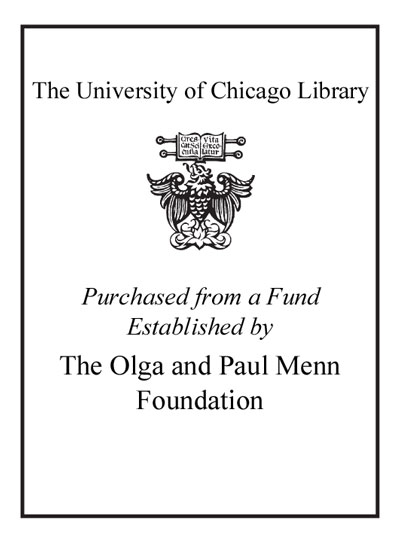Review by Choice Review
The history of collecting is an increasingly important part of the history of art: at its best an epitome of reception theory, it frees us from the bindings of style and artistic biography, even of stubborn Zeitgeist and its ghosts, leaving a history constituted by shifting attributions and vacillating significances, as well as a record that, ipso facto, acknowledges the monetary, material, and public relations aspects of the tradition. The beloved and well-published Frick Collection in New York is but one of the museums left by industrialist Henry and daughter Helen; and although Henry has a prior biography, Helen, who died in 1984, has not, and her life and collecting has its own interest. This ample, and at times excessively detailed, account by Henry's great-grandchild manages at once to be art historically of dubious value (paintings are with monotonous regularity assigned significance as reminders of troubles in their owner's lives, most often the tragic childhood death of the author's namesake, Helen's sister, but this interpretive strategy goes so far as to take Ruisdael landscapes as reminders of the horrific 1889 Johnstown flood), at the same time that it offers a good read, excellent color plates, a convenient appendix chronicling acquisitions and deacquisitions, and the occasional aper,cu. General readers; undergraduates through professionals. P. Emison; University of New Hampshire
Copyright American Library Association, used with permission.
Review by Booklist Review
A work of psychobiography and psychoart criticism by a great-granddaughter of the subject (and former wife of a grandson of Margaret Sanger). Frick, an industrialist from the age of the great industrial moguls, was also one of the great art collectors of his day (and his grand residence-cum-museum on Fifth Avenue in New York still stands as a testament to his taste). But Sanger illuminates the tragic story of his daughter, Martha, whose death at six was the dominant influence in the Frick household forever after. (Even the author, the tragic girl's namesake, was told years later by her mother that because her name was Martha she carried the curse of the dead girl!) When Frick was attacked in one of the most bizarre assassination attempts in the annals of the rich and famous (he survived both gunshots and stabbing in the same attempt), he claimed to have seen a vision of his deceased daughter before him. Destined to be well regarded, this beautiful volume contains many color prints, with commentary, from Frick's collections. --Allen Weakland
From Booklist, Copyright (c) American Library Association. Used with permission.
Review by Publisher's Weekly Review
How one of the most notorious turn-of-the-century robber barons, the "shoot-to-kill" strikebreaker Henry Clay Frick (1849-1919), amassed what is arguably the greatest collection of Old Master paintings in New York is a paradox that is difficult to explain. Nearly killed twiceÄby scarlet fever as a child and later an anarchist's bulletÄthe unlovable Frick gloomily marches through this illustrated biographyÄwritten by his great granddaughterÄachieving new heights of infamy, erecting 12-foot walls equipped with rifle holes around his factories and hiring Pinkerton detectives to strong-arm his employees. In Sanger's broadly psychoanalytical study, based on previously undisclosed family papers, the event that unlocks Citizen Frick's impulse to collect is the death of his young daughter Martha (nicknamed "Rosebud"). Sanger often explains Frick's choice in paintings by finding latent references in them to the trauma of his daughter's demise. For example, Vermeer's Mistress and Maid, which shows the delivery of a letter, becomes a possible reminder to Frick of his anguished correspondence with his wife during his daughter's illness. This approach leaves many art historical questions open: Was the collection Frick's taste alone? What was the role of Roland Knoedler, Frick's dealer (handled summarily but not sufficiently)? How did Frick's taste compare to that of the other great industrialist-collectors of the period? Sanger does an admirable job of detailing Frick's ascent to power; as the life of a tycoon, her biography is eminently readable and informative. The mystery of how Frick managed to assemble one of the great collections of art on this continent, however, remains in large part unilluminated. 225 full-color and 145 b&w illustrations. (Oct.) (c) Copyright PWxyz, LLC. All rights reserved
(c) Copyright PWxyz, LLC. All rights reserved
Review by Library Journal Review
Two recent biographies of Henry Clay Frick (1849-1919)ÄKenneth Warren's Triumphant Capitalism: Henry Clay Frick and the Industrial Transformation of America (LJ 7/96) and Samuel Agnew Schreiner's Henry Clay Frick: The Gospel of Greed (LJ 2/15/95) now out of print, detail the life of this major industrialist/philanthropist. Both take a critical view of his actions with the Homestead strikers and labor in general and of his relationships with such fellow industrialists as Andrew Carnegie and J.P. Morgan. Sanger, his great-granddaughter, does pretty much the same: she traces his life from birth through death, and she critically examines his motives for various decisionsÄespecially those involving his art collection. She comments not only on why he purchased particular works but on the works themselves. This well-documented and very readable biography/art catalog contains over 200 reproductions as well as illustrations and photographs related to Frick's life in western Pennsylvania and New York City. Art libraries as well as art departments in large public and academic libraries should consider this for inclusion.ÄSteven J. Mayover, Free Lib. of Philadelphia (c) Copyright 2010. Library Journals LLC, a wholly owned subsidiary of Media Source, Inc. No redistribution permitted.
(c) Copyright Library Journals LLC, a wholly owned subsidiary of Media Source, Inc. No redistribution permitted.
Review by Choice Review
Review by Booklist Review
Review by Publisher's Weekly Review
Review by Library Journal Review

